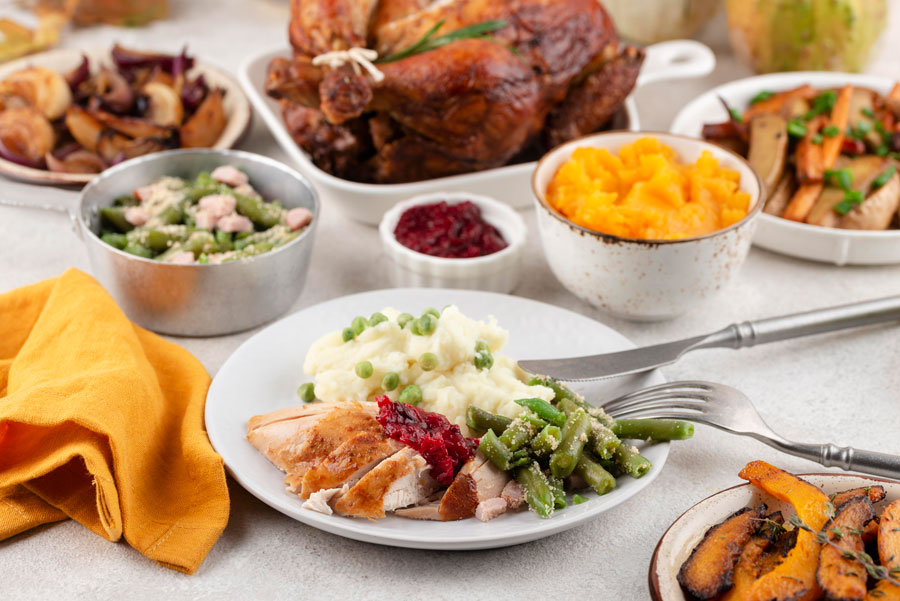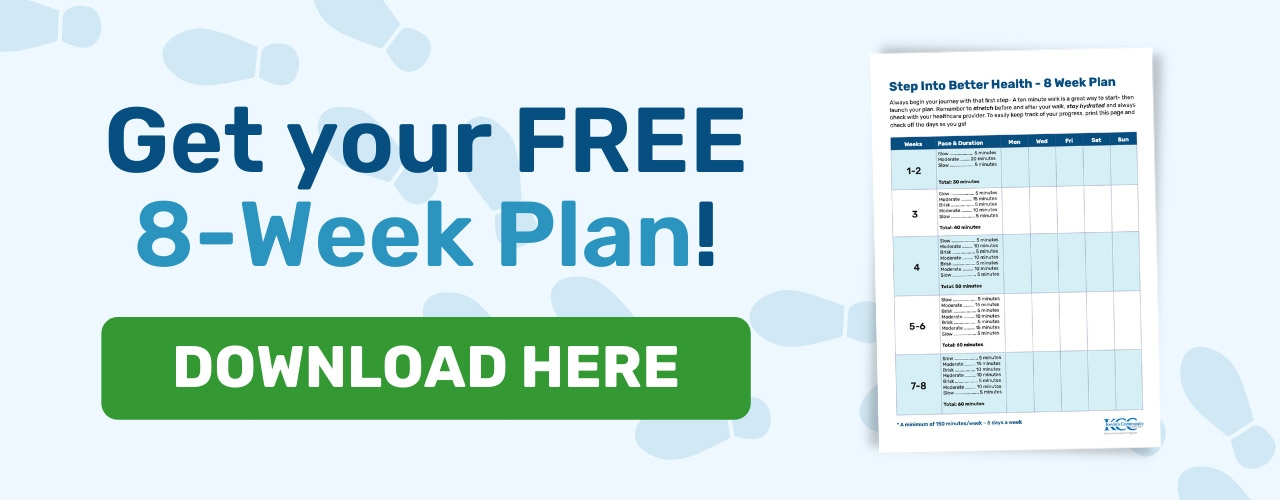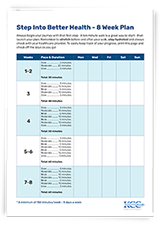The holly, jolly time that begins after sugar-laden Halloween and continues for the 9 weeks through the guilt-ridden resolutions that ring in the New Year can be perilous for anyone with a sensitivity to blood sugar maintenance such as those controlling Type II Diabetes. It is especially challenging during the festive five-week span: Thanksgiving, Hannukah, Christmas, and New Year celebrations that are filled with lots of irresistible food.
The holiday season brings laughter, cheer, and goodwill— it can also bring unwanted weight gain from all those festive foods and drinks. This is the first year since the COVID pandemic to gather with friends and family there may be a temptation to over-indulge. By making a few modifications and some creative planning you can have your fruitcake and eat it too!
Below are tips to include in your holiday planning and you will not have to dread the New Year resolution reality check.
1. Exercise Is Essential For Weight Loss
This does not mean that you suddenly need to begin training for a half marathon, but it is essential to be active every week. Consider muscle cultivation and maintenance a priority especially as birthdays accumulate. This is a case of “use it or lose it” and the more muscle, especially the large muscle groups that you can work and build the more calories you will efficiently burn. Spending five minutes doing one daily resistance exercise is all it takes to build and maintain muscle, reduce fat, and protect bones. For more easy fat-frying tips, check out these 44 Ways to Lose Inches of Body Fat!
2. Get stepping
The recommended 150 minutes of activity can be broken up to 30 minutes a day over 5 days. Walking at a brisk pace is good for your heart, waist, and blood sugar management. Walking throughout the day will allow you to accumulate 10,000 steps and keep your health plan on track.
It is just as effective if you break up your activity throughout the day, just keep moving, although it is recommended if you want the fastest weight loss results, add a 30-minute vigorous activity shortly after you get up. Shape.com and Bodybuilding.com have a list of post-Thanksgiving workouts to help with your fitness plan.
3. Lower the Temperatures
Data from a study that has been published in the journal Diabetes suggests that turning down the thermostat and sleeping at 66 degrees, positively impacted the rate of fat loss by the subjects of the study. Participants spent a few weeks sleeping in bedrooms with varying temperatures: a neutral 75 degrees, a cool 66 degrees, and a balmy 81 degrees. It showed that colder temperatures subtly enhance the effectiveness bodies ability to burn the fat stored in your belly.
4. Swap Out Traditional Holiday Foods for Healthy Options
The average holiday dinner ranges from 3,000 to 4,500 calories. To put it in perspective 4,500 calories are the same as 14 slices of pumpkin pie.
There is no need to feel deprived, go hungry, or left out of the holiday fun to make healthy choices, manage blood sugar levels, and not blow your weight loss progress. It’s typical to miss self-care and time for exercise during the holidays and who hasn’t given in to “just one more” piece of pie, but don’t let that stop you from making healthy choices. Don’t let a slip here or there sink the ship- lean into yummy alternatives that salvage the moment.
If you are managing your weight, on a weight loss plan, controlling blood sugar for diabetes, or just want healthier choices here are some easy options to make the traditional dishes healthier.
- Add a salad to your meal to fill up on healthy veggies but keep a non-creamy dressing on the side
- Switch to cauliflower mashed potatoes instead of white potatoes( recipe below)
5. Meet Your Daily Protein Quota
In your effort to stay on your course of weight management or weight loss it’s important to keep your blood sugar levels stable, for your health and to harness cravings. To keep hunger at bay, have three meals and two snacks a day (all of these 25 Best Store-Bought High-Protein Snacks are healthy picks). Adding fiber and protein to each meal will ensure that you stay full and satiated.
The daily protein quota is recommended at 46 grams for women and 56 grams for men. Snacks that are high-protein/low sugar content help stabilize blood sugar, cravings, and energy throughout the day and enable meeting this quota. High protein snacks also help fuel weight loss efforts by boosting metabolism and reducing hunger pangs. Proteins are considered the building blocks of our bodies. The average adult should aim for between 8-20 grams of protein/serving. Read labels carefully, especially the “ healthy ones” and avoid prepackaged snacks- that have more than 15 grams of sugar/serving.
6. High Protein Breakfast Starts the Day
Start your day with a protein-filled breakfast to stabilize your blood levels, control your cravings, and give energy. Spinach omelets, hardboiled eggs, cottage cheese with fruit, and protein drinks such as a fat-burning homemade high protein smoothie for breakfast are all options that provide a great way to stay full and help navigate the high-stress of holiday season.
7. Space Your Meals To Manage Blood Levels
Plan to eat lunch and dinner between 3-5 hours apart throughout the day with healthy snacks between. Remember that you should conclude your meal intake by 6:-6:30 pm. Re-introducing this schedule will help manage your blood sugar, insulin levels, control your hunger hormones and maximize your metabolism.
8. Plan the Carbs, Control the Sugar
Cutting back on carbs, but not cutting them out completely, will help level energy and hunger. At each meal, aim for a third to a half cup of carbs like whole grains and starchy vegetables (sweet potatoes, chickpeas, lentils, etc.). Skip the creamy or cheesy dips and sauces. Instead, whip up some hummus from lentils and chickpeas, which are a rich source of vegetarian protein, have been shown to reduce inflammation, lower cholesterol, promote fat metabolism, and boost satiety. They’re also a source of resistant starch, a slow-digesting fiber that triggers the release of acetate, a molecule in the gut that tells the brain when to stop eating.
9. Control your portions
Know the correct portion sizes of different food options and if possible eat your Thanksgiving meal off a smaller plate. Don’t go into the social events of the holiday season unprepared and ravenous. Make sure you have a healthy high protein snack beforehand. And arriving hungry at a holiday get-together makes it that much easier to overeat. So be smart: If you know you will be going to a party and don’t want to spoil your appetite, have a healthy snack to tide you over. It will help stabilize your blood pressure and keep you full – so you’re less likely to overindulge on all the not-so-healthy stuff later.
10. Drink lots of water
Staying hydrated is important every day since about 60% of the body is water, but during the holidays it is not always a priority. It’s even more important for anyone trying to lose weight to increase their water intake on holidays. Drinking lots of water helps you feel full so you don’t stuff yourself full. In addition, staying hydrated helps maintain blood levels, improves sleep quality, cognition, and mood.
11. Limit Alcohol
When it comes to the holidays we know that avoiding alcohol may be difficult so plan. It is well-known that holiday times may include alcohol that can add hundreds of empty calories to one’s daily intake. During the season to be jolly have low-calorie options and non-alcoholic alternatives so you don’t miss any fun.
For example, instead of an 8 oz glass of thick and creamy traditional eggnog that has the same number of calories as three glasses of wine or 440 calories, opt for a Hot Toddy, made with ginger, tea, and whiskey at only 130 calories! If you are indulging in alcohol, opt for healthier options. Make a 45 calorie cocktail such as a Holiday Spritzer. You also might consider a Vodka or Gin tonic, both are lower-calorie options.
12. Type II Diabetes
You must manage your blood levels, especially during this high fat, high sugar-filled season.
Ask a close friend or family to help keep you on track and keep them close during gatherings and events where food is present.
- Don’t skip meals. But skipping meals can wreak havoc on your blood sugar. According to the American Diabetes Association, skipping meals makes it much harder to keep blood glucose levels in check throughout the day.
- Holiday Stress is real. Holidays can be a stressful time of year for most, and stress can inhibit your progress when it comes to weight loss and sticking to your diet in general. Take some time for self-care, get plenty of sleep, and relax during this busy time because stress may also cause high sugar cravings, disrupt your blood sugar levels, and drain your willpower.
- Choose Carefully. At the social gatherings and dinners, choose fruits and vegetables served raw, grilled, or steamed. Avoid dishes based on creams, gravies, and butter.
- Keep Moving. After your meal, take a walk. Being physically active every day must become a priority. Staying active is essential to manage or lose weight, control blood sugar levels, improve endurance and improve cardiac health.



